| | Aphid | Clipper weevil | Leaf rollers | Mites | Slugs | Spittle bug | Strawberry root weevil | Tarnished plant bug | Wasps/yellow jackets/hornets
An important part in the production of any fruit crop is to know what type of insects could cause production losses. A crop is at risk throughout the fruiting cycle. Insects can attack plants during flowering, fruit formation or just before harvest of the plump, juicy berries. A successful pest management program includes: insect identification; pest number and damage monitoring; what population numbers warrent control and knowing when the pest can be effectively controlled.
Aphid
Identification
- the aphid is 1-3 mm long, soft-bodied and pear-shaped
- main identifying feature: cornicles (tailpipes sticking out of the back end)
- variety of colors: green, yellow, pink, white, bronze, dark-brown or black
- adults can be winged or wingless
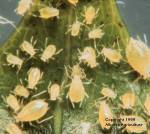
Green Peach Aphid
Life cycle
- overwinters as egg on the host plant
- hatchs into a "stem" mother and starts bearing live young; which, in turn, bear live young
- each mature aphid can produce 50-100 offspring
- 15-30 generations produced per season
- aphids can reproduce either sexually or asexually, males are not produced until fall; mating occurs and either an egg or another stem mother is produced which lays the overwintering egg
- moist, cool weather favors aphid outbreaks
Damage
- feeding symptoms include: leaf discoloration, flattened appearance, shiny (from honey dew) and, in severe cases, wilted plants
- produces a sticky substance called honey dew; makes the leaves and fruit sticky and can promote the growth of sooty mold fungi (not harmful to the plant but both can make the fruit unsalable)
- it seldom causes much direct injury, unless present in large numbers
- can transmit viral diseases
Monitoring
- generally, they are found in clusters on the new growth, stems, buds or on underside of leaves
- in young plants, aphids may cluster near the base of the plant
- look for symptoms weekly
- severe infestations are often visible from the edge of the field
- economic threshold--30 aphids per plant
- before spraying consider: weather conditions, presence and abundance of natural enemies, value and stage of the crop
Cultural control
- start with clean stock
- there are a wide range of natural predators: lady bugs, lace wings, and predatory wasps
Clipper Weevil
Identification
- 2-3 mm long, dark reddish-brown weevil
- it has rows of tiny pits and two small white spots with dark centers on its back
- the long snout is about as long as the insect's body
- the legless larva is 2 mm long, white to yellow white, thick bodied and curved
Life cycle
- the female inserts a single egg inside an almost mature bud and then girdles the bud to prevent it from opening and exposing the larva
- in 1 week, the egg hatches
- adults emerge in late June; and, in few weeks, they seek a hibernation site, remaining there until the following spring
Damage
- holes in flowers and petals
- stems that are chewed or almost clipped through and left dangling
- the dead straw-colored section is easy to see against the green of the plant
Monitoring
- weekly checks beginning in May with the early-blooming varieties
- first place to look--closest to woodlots and shelterbelts
- economic threshold is one or two clipped buds per metre of strawberry row
- more information on monitoring for the clipper weevil is described in the Ontario Ministry of Agriculture and Food,Agdex 232/620 Strawberry Clipper Weevil: A Major Pest of Strawberry.
Cultural control
- minimize the amount of trash in the fields in mid to late summer
- separate new plantings from old
- vigorous tillage of old beds after the final harvest while the clippers are pupating will reduce the movement of clippers from infested fields to non-infested fields
Leaf Rollers
Identification
- a diverse group of moths
- the caterpillar is slender, green to brown, 12 mm long with dark-brown or black head
- very active and moves backwards when disturbed
Life cycle
- the eggs are laid on the strawberry leaves
- larvae change from pale green to greyish brown as they mature
- they pupate rolled in the leaf
- could be 2 generations per year
Damage
- holes are eaten in the leaves; later the leaves are folded in half and webbed together, causing the leaves to turn brown and die
- the fruit is rarely attacked
- damage is usually minimal
- damage is most common on new plantings late in the season
Monitoring
- start in the spring
- look for the folded or rolled leaves, also discolored leaf areas showing some feeding damage
- unroll leaves and look for small green caterpillars
- if no caterpillar, then the insect is gone
- economic threshold--spraying is seldom necessary as healthy strawberry plants have an abundance of leaves and the loss of a few leaves has little effect on fruit production
Cultural control
- there are several natural predators and parasites that do keep the populations in check
- spraying is difficult; as once the leaves are rolled, the insect is protected
Mites
Identification
- the cyclamen mite (CM) is oval, semi-transparent,.25 mm long, shiny and light-green, amber or light tan colored, the nymphs are milky-white; the females are pale-brown
- the spider mite (SM) is .5 mm, oval, greenish-yellow with 2 irregular dark spots on back
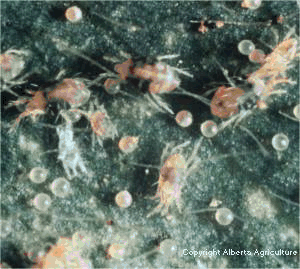
Spider Mite
Life cycle
- CM overwinter as egg, nymph or adult on underside of leaf, close to the ground
- CM lay eggs in dark moist places on the host plant (buds and leaf clusters), several generations can overlap
- each female can produce up to 90 eggs; 80% develop into females
- SM overwinter as adults
- when the plant starts to grow, mites mate and lay eggs
- the eggs hatch and begin to feed
- there can be several generations overlapping
- hot, dry weather favours population explosions of SM (depending on the species)
Damage
- CM--feeding reduces vigour of plants
- growth appears retarded, twisted, and distorted
- stems and petioles of leaves remain short and do not elongate
- high infestations cause new leaves to form a compact mass in crown centre
- at this point, the leaves are usually brownish green
- in high infestations, CM move out to feed on the flowers, causing flower death; fruits are small, dry and distorted, and the seeds stand out on the berry
- symptoms are apparent, even at low population levels
- SM feed on the leaf underside, preferring the young leaves in the crown
- feeding damage causes yellow spots (mottling or stippling), leaf crinkling, browning and leaf curling
- high populations will cause loss in plant vigor and fruit will not form
Monitoring
- CM--check the midrib of leaflets where they join the petiole
- economic threshold--10-15 mites per leaf, densities of 45-65 mites per leaf can reduce yield by 33%
- SM--examine for webbing between or under the leaflets, damage shows up in dry areas of field
- diagnostic tool--breathe on leaflets, this causes the mites to scurry about; or, tap the leaf over a white sheet of paper, making the pest visible
- economic threshold is 5 mites per leaf before July 30
Cultural control
- CM control is hard because the mites hide in closed leaf and flower clusters where the penetration of a pesticide is almost impossible
- SM predators become established as a strawberry planting matures
- irrigate regularly to avoid water stress on the plants
- eliminate weeds that can also be hosts
- cultivate in the fall to disturb the overwintering sites
- SMs have naturally occurring predators
Slugs
Identification
- slugs are 5-7 cm long, greyish, grey-brown or almost black in color, depending on the species and age of the gastropod
- they hide during the heat of the day in moist-dark places like soil crevices, earthworm holes or under leaves
Life cycle
- overwinters as adults in trash and leaf litter of hedge rows and windbreaks
- slugs have both male and female sex organs (hermaphrodites)
- mating usually takes place; but, under extreme situations, they can fertilize themselves
- eggs are oval clear, cream or yellow, up to 3 mm long and are in batches of 20 or more
- the eggs can lay dormant until sufficient moisture is available because they are protected by a jelly like substance
- eggs can be produced at anytime during the growing season.
Damage
- can be serious in wet areas or through out over-irrigated fields
- most damaging to young plants, but can contaminate fruit by feces and slime
- most pickers either will not pick or will toss away slug contaminated fruit
- foraging is done in a relatively small area and they usually return to the same spot to hide during the day, unless this spot dries out
- feeding produces large ragged holes; they rasp away the plant tissue, then suck up the residue
- feeding is done at night, most active 2 hours after sunset to 2 hours before sunrise, especially when the temperature is below 23°C.
Monitoring
- watch for slime trails and shredded leaves
- they can be found resting or hiding when populations are high
Cultural control
- predators--ducks, chickens, garter snakes, toads and salamanders
- insect predators--ground beetles, soldier beetles, centipedes and rove beetles
- prevention is the best method of control
- limit excessive straw use, vigorous tilling at renovation also helps
- avoid planting in perennially wet spots
- clean equipment when moving from a slug infested area to a clean area
- remove the organic litter on the soil surface of the shelter belts
Chemical control
- chemical controls are available; slug baits have been somewhat successful--follow label directions
- till headlands and inter-row areas
Spittle Bug
Identification
- protects itself by covering its body with a white, frothy spit like substance
- it is 1-2 cm or more and resembles a fat aphid
- nymphs are white to lemon yellow
- adults are greyish-brown, 6 mm long
- it can hop and fly
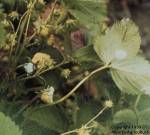
Spittle Bug Masses
Life cycle
- overwinters as an egg in masses of 2-30 on lower parts of crown
- eggs hatch in May
- nymphs take 5-8 weeks to reach adulthood
- adults migrate in June and return in September and October to lay their eggs
Damage
- nymphs pierce the plant stems and suck plant juice
- feeds at the base of the plants and later moves up into the developing foliage
- excessive feeding causes distortion of leaves, shortened fruit spurs and small berries
- plants will recover after the bug moves on
Monitoring
- every 2 weeks, randomly select five 2 ft2 areas per acre
- look for characteristic spittle at the base of plants in the crown area
- nymphs will be at base of plant, so spreading the plant is necessary
- some studies indicate that pick-your-own customers are willing to accept a spittle mass of about 2 masses per 2 ft2 without complaints
- aesthetic threshold 1 froth mass per square foot
Cultural control
- fields that had been hay or pasture in the rotation are at a higher risk for spittle bugs
- with good weed control, they are less likely to return in the fall
- weed free planting
- populations are higher in fields surrounded with grasses and broad leafed plants like golden rod
Chemical control
- experience indicates that when chemicals are applied for the control of tarnished plant bug, the spittle bug is controlled
- spittle acts as protective covering, making chemical control hard; especially, if the spray coverage is poor and low water volumes are used
Strawberry Root Weevil
Identification
- adult are 5-8 mm long, usually black, but can be light to dark brown, hump-backed and hard-bodied
- wing covers have rows of round punctures and it can not fly
- it has a blunt snout
- larvae are 6 mm long, legless grubs, pinkish-white with a C-shaped body and brown head
| |
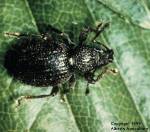
Strawberry Root Weevil adult |
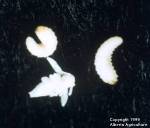
Strawberry Root Weevil larvae |
Life cycle
- overwinters as adults and larvae under soil trash and around the base of host plant
- emerge in late spring and early summer
- migrate, looking for food hosts to lay their eggs beside
- also migrate in the fall looking for overwintering sites (that is when most of us see them)
- no males are known, each female can lay 200-300 small white eggs in soil cracks
- in 2-3 weeks the eggs hatch, larvae burrow into ground and begin feeding on host plant roots
Damage
- adult feeding causes a notching on the leaves
- does little harm to plant but indicates the pest is there
- grub feeds on the rootlets and can burrow into the main root weakening the plant, predisposing it to disease and winter injury
- injured plants may wilt and die during dry summer periods
Monitoring
- inspect the field edges every week or two during July and August, look for the notched leaf margins
- a sweep net will help to collect the weevils for identification
- in the fall, check for larvae by collecting stressed plants; slit open the roots and check for tunneling and larvae
Cultural control
- cultivated soil around the field perimeter creates a barrier
- crop rotation
- remember, they have to walk through the field
Tarnished Plant Bug
Identification
- adults are 5-6 mm long, 2.5 mm wide and flattened, pale green to reddish-brown with a distinct triangle or "V" mark 1/3 way down back
- they are difficult to see because they fly or move rapidly
- young nymphs are dull blue-green; look similar to aphids, but move faster and lack cornicles
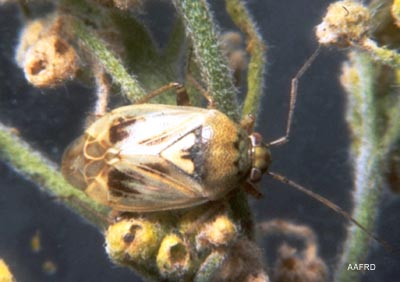
Tarnished Plant Bug
Life cycle
- adults overwinter under debris or plant cover along fence lines
- in spring, they feed on early growing plants, mate and migrate to crops suitable for feeding
- egg laying may be as early as mid-May (south) to mid-June (Peace country)
- nymphs develop into adults in 12-34 days depending on the temperatures; the hotter the weather, the faster they develop
- they are strong flyers
Damage
- TPB punctures the plant tissue and sucks the juice when feeding
- TPB punctures the seeds (usually in one area on the berry)
- those seeds punctured abort and the hormone production of these seeds stops, as a result, the tissue around that area stops growing causing "cat facing" or "button berries" or "apical seediness"
- hollow seeds (turn a brown color) distinguish TPB damage from poor pollination
- generally, the earlier the feeding takes place, the more severe the fruit deformation
- one nymph per inflorescence can result in 20-30% of the fruit being injured
Monitoring
- tap a flower or a fruit cluster into a colored dish (any color other than white or green); the dish needs to be deep enough to allow for the insects to be trapped, but shallow enough to allow for inspection
- how to monitor--tap 3 flower clusters into dish from 5 different locations in the field
- if there are .5 nymphs per cluster, then it is time to spray
- another method of monitoring for the TPB is described in the Ontario Ministry of Agriculture and Food Tarnished Plant Bug: A Major Pest of Strawberry Agdex 232/620.
Cultural control
- get rid of weeds in and near strawberry plantings
- mow permanent sod in the fall to prevent overwintering sites
- the TPB moves into the berry crop when alfalfa fields near strawberry fields are cut
Wasps/Yellow jackets/Hornets
Identification
- Yellow jackets and Hornets belong to the family of Wasps
- Hornets are black with yellowish white markings and approximately 19 mm long
- Yellow jackets are smaller and black with bright yellow markings
- wasps are hunters and are useful in controlling caterpillars and flies, but they can become pests in the berry fields
Life cycle
- warm, dry springs produce larger wasp problems in August than do wet, cool springs
- in spring, a fertilized queen emerges from hibernation
- she chooses a good nesting spot which could be in a hole in the ground (a mouse burrow), a tree branch, bush, under the eaves or in the walls of a building
- the nest is built by chewing wood fibres into a pulpy mass
- the queen lays eggs which hatch into legless, blind larvae
- larvae last 2 weeks, then pupate
- in 3 weeks, adult females emerge and begin to tend the queen
- in August, male and new queen cells are produced
- in early fall, the males and new queens emerge; mating takes place on the wing
- males die and fertilized queens overwinter in protected sites like stumps or hollow logs
- the old nest is abandoned and never used again
Damage
- wasps are attracted to the ripe or injured fruit as a source of sugar and moisture
- they can be dangerous to pickers because they sting, which is painful, and some people are allergic to the venom (which could result in death)
Cultural control
- prompt harvesting of ripe berries and clean picking practices
- hang a piece of meat or fish over a bucket of water with detergent in it, wasps will take a mouthful and fall into the water and drown
- a 2 litre soda bottle with about 5 cm of soda left in the bottom attracts wasps into bottle
- a basin with a few inches of water and syrup (like pancake) in it will attract the insect and it drowns in the water
- set the nest on fire with a torch
- knock the nest into a sack and burn it
- carry out control methods after dusk, after the wasps have settled for the night
- wear protective clothes (coveralls, gloves and hat netting with ends tucked into the collar)
- if necessary to use a light, do not hold the flashlight, set it to the side and shine the light on nest
Chemical control
- spray insecticide into the entrance of the nest, do this after dark
- for ground nests, stuff insecticide soaked cotton or steel wool into the nest entrance
|
|